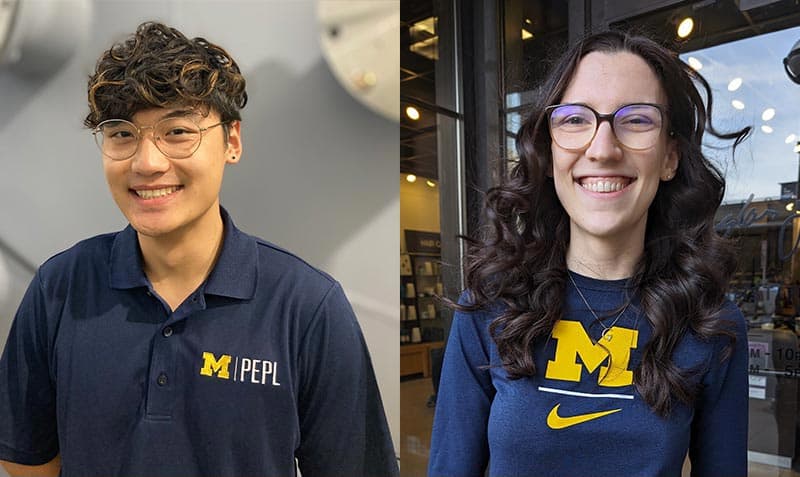
Two Michigan Aerospace Students Awarded the Highly Coveted NASA Space Technology Graduate Research Opportunity
Students working in the Plasmadynamics and Electric Propulsion Laboratory receive NASA funding to further their research efforts

Students working in the Plasmadynamics and Electric Propulsion Laboratory receive NASA funding to further their research efforts
The highly competitive NASA Space Technology Graduate Research Opportunity (NSTGRO) has been awarded to two outstanding PhD students, both working alongside Associate Professor Benjamin Jorns in the Plasmadynamics and Electric Propulsion Laboratory (PEPL). Congratulations to first-year PhD student Miron Liu and second year PhD student Grace Zoppi for this recognition.
NSTGRO is a four-year NASA-sponsored fellowship that seeks to sponsor “graduate students who show significant potential to contribute to NASA’s goal of creating innovative new space technologies for our nation’s science, exploration and economic future.” Awardees are also matched with a NASA subject matter expert to serve as a research collaborator and visit NASA centers for a few months each year to perform research and collaborate with NASA engineers.
Grace Zoppi
Zoppi is a second-year PhD student and has focused her research interests on studying Rotating Magnetic Field (RMF) thrusters, a type of electric propulsion device that utilizes a high frequency rotating magnetic field to produce force. This RMF is generated through an antenna configuration which couples energy inductively into the plasma, a design characteristic that distinguishes this technology from more conventional electric propulsion like Hall thrusters. “This technology is at a low TRL so my research focuses on the design, construction and testing of a new RMF thruster to increase the efficiency of the device,” stated Zoppi.
Upon receiving the award, she commented, “One of the unique and most exciting portions of this fellowship is the opportunity to work as a visiting technologist at a NASA facility for 10 weeks every year. I am incredibly excited to live out a childhood dream of working for NASA, supporting programs that will one day fly in space, as well as connecting and learning from some of the most influential leaders in the electric propulsion community.”
Additionally, Zoppi explained her excitement upon finding out she received this award while on her way to an orienteering competition in Ohio which took place in conjunction with the recent April solar eclipse. “The competition was a qualifying event for a spot on Team USA at the World University Orienteering Championship (WUOC) in Bulgaria this summer, and the thrilling NASA fellowship news gave me an ultra boost of adrenaline for a superb Friday race which helped to earn me a spot on the team!”
Miron Liu
Liu is a first-year PhD student focusing on developing novel designs for magnetically shielded Hall Effect thrusters where the last known mechanism for life-limiting erosion, sputtering of the magnetic poles, is eliminated.
The work he has been doing in PEPL revolves around first developing experimental methodologies to leverage novel plasma diagnostics, providing the ability to shed more light on the types of instabilities that induce pole erosion. Subsequently, he will apply insights gained to design and test new thruster variants that actively or passively dampen erosion-inducing instabilities and associated erosion processes. “The hope is that this work will advance our understanding of plasma instabilities in electric propulsion devices and culminate in the development of a magnetically shielded Hall Effect thruster without pole erosion,” stated Liu.
Upon receiving the award, he commented, “Laying the foundation for a multi-planetary future for humanity is a mission I am deeply committed to. It is why I chose to pursue aerospace engineering, and why I have chosen to pursue graduate studies. With the support of the NSTGRO, I will be able to conduct salient research aimed at further developing key enabling technologies for advancing human exploration and development of space. Being able to contribute meaningfully to this effort means a lot to me. I greatly appreciate this opportunity from NASA and look forward to conducting the proposed research under this fellowship.”